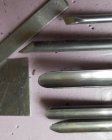I have been doing woodturning for a little over three years and have tried a variety of different types of projects. Lately I have been doing a lot of delicate finials (think Cindy Drozda). I was talking with another woodturner and mentioned that everytime I tried to cut a deep groove (terminology??) between two beads the top of the flute would contact the opposing element causing problems. I was informed that instead of using a 3/8 inch (Sorby) spindle gouge I needed to use a 3/8 detail spindle gouge. Is this true? Do I really need yet another 3/8 inch gouge? Please don't change the discussion to be skews!
Assuming that I do need a spindle detail gouge I have narrowed my search to either the Thompson or the D-Way. The dividing factor seems to be M42 vs. C-10 and if it cyro treated. Since I am currently using white grinding stones I doubt it makes much difference. I do plan on upgrading to CBN but that is another discussion. Is there really a practical, noticable difference between the tools or what steels they are made of?
Assuming that I do need a spindle detail gouge I have narrowed my search to either the Thompson or the D-Way. The dividing factor seems to be M42 vs. C-10 and if it cyro treated. Since I am currently using white grinding stones I doubt it makes much difference. I do plan on upgrading to CBN but that is another discussion. Is there really a practical, noticable difference between the tools or what steels they are made of?


